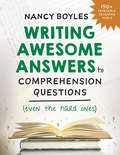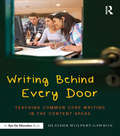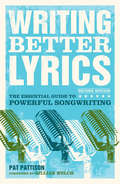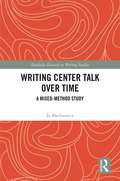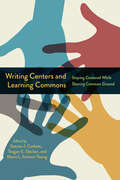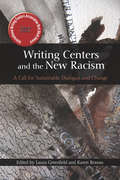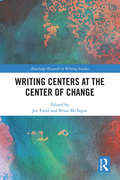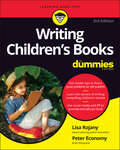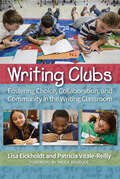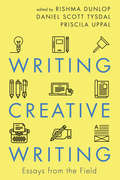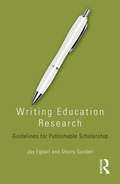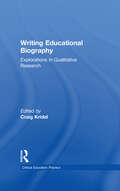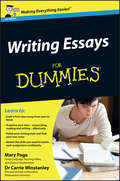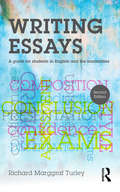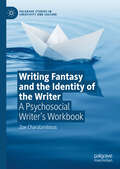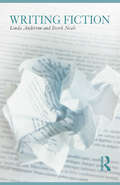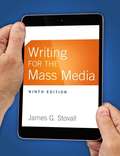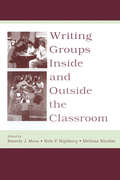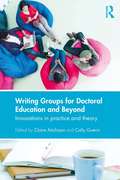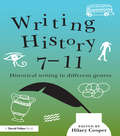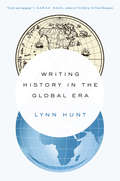- Table View
- List View
Writing Awesome Answers to Comprehension Questions (Even the Hard Ones)
by Nancy BoylesHelp students appreciate texts and write about them with conviction. Responding to a comprehension question is a surprisingly complex task. It draws on multiple skills: students must be able to read and analyze a text passage; consider what aspect of the text the question addresses; and then quickly and concisely write about their ideas, citing evidence to support them. Hence the prominence of constructed-response questions in standardized testing. In this refreshingly clear and upbeat guide, literacy consultant Nancy Boyles gives a step-by-step demonstration of how to help students achieve success with this task—and in the process of unpacking the steps involved, demonstrates how the instruction can inspire teachers’ creativity as well as deepen students’ literacy skills. Filled with ready-to-use scaffolds for every stage of instruction—sets of sample questions, anchor charts, cue cards, answer frames—this is a one-stop resource for teaching students how to organize their thoughts about what they’ve read, and then set them down in writing.
Writing Behind Every Door: Teaching Common Core Writing in the Content Areas
by Heather Wolpert-GawronFor students to become college-ready writers, they must be exposed to writing throughout the school day, not just in English class. This practical book shows teachers in all subject areas how to meet the Common Core State Standards and make writing come alive in the classroom. Award-winning educator Heather Wolpert-Gawron provides effective and exciting ideas for teaching argument writing, informational writing, project-based writing, and writing with technology. Each chapter is filled with strategies, prompts, and rubrics you can use immediately. Special Features: A variety of writing strategies that work in any subject area Tips for developing meaningful prompts Diagrams and templates that you can use with your students Rubrics for assessing writing, as well as ideas for having students create their own rubrics Samples of student work in different formats Ideas for teaching students to break the Google homepage habit and conduct effective research Cross-curricular writing assignments for science, history, ELA, electives, and PE Suggestions for teaching summary writing, an essential academic skill Ideas for staff professional development on Common Core writing
Writing Better Lyrics Second Edition: Essential Guide To Lyric Form And Structure: Tools And Techniques For Writing Better Lyrics (Songwriting And Lyrics Ser.)
by Pat PattisonPattison presents a unique, in-depth approach to the process of lyric writing. Songwriters will examine 17 extraordinary songs and learn the distinct elements that make them so effective. Pattison then presents more than 30 lyric-writing exercises designed to achieve the same results. From generating lyric ideas and managing repetition to developing verses, it's all here. Songwriters will: find warm-up exercises that revolutionize songwriting imagery; use a rhyming dictionary and a thesaurus to generate ideas and find snappy rhyme; create meaningful metaphors and similes while avoiding cliches; develop verses by using or breaking conventional rules; experiment with point of view in every lyric to make a song stand out
Writing Center Talk over Time: A Mixed-Method Study (Routledge Research in Writing Studies)
by Jo MackiewiczIn the last 15 to 20 years, writing centers have placed greater importance on tutor training, focusing on teaching tutors best practices in fostering student writers’ engagement and writing skills. Writing Center Talk over Time explores the importance of writing center talk and demonstrates the efficacy of tutor training. The book uses corpus-driven analysis and discourse analysis to examine the changes in writing center talk over time to provide a baseline understanding of the very heart of writing center work: the talk that unfolds between tutors and student writers. It is this talk that, at its best, motivates student writers to continue to improve their writing and scaffolds their learning and that makes tutors proud of the service that they provide. The methods and analysis of this study are intended to inform other researchers so that they may conduct further research into the efficacy of writing center talk.
Writing Centers and Learning Commons: Staying Centered While Sharing Common Ground
by Steven J. Corbett Teagan E. Decker Maria L. L. Soriano YoungWriting Centers and Learning Commons presents program administrators, directors, staff, and tutors with theoretical rationales, experiential journeys, and go-to practical designs and strategies for the many questions involved when writing centers find themselves operating in shared environments. The chapters comprehensively examine the ways writing centers make the most of sharing common ground. Directors, coordinators, administrators, and stakeholders draw on past and present attention to writing center studies to help shape the future of the learning commons and narrate their substantial collective experience with collaborative efforts to stay centered while empowering colleagues and student writers at their institutions. The contributors explore what is gained and lost by affiliating writing centers with learning commons, how to create sound pedagogical foundations that include writing center philosophies, how writing center practices evolved or have been altered by learning center affiliations, and more. Writing Centers and Learning Commons is for all stakeholders of writing in and across campuses collaborating on (by choice or edict), or wishing to explore the possibilities of, a learning commons enterprise. Contributors: Alice Batt, Cassandra Book, Charles A. Braman, Elizabeth Busekrus Blackmon, Virginia Crank, Celeste Del Russo, Patricia Egbert, Christopher Giroux, Alexis Hart, Suzanne Julian, Kristen Miller, Robby Nadler, Michele Ostrow, Helen Raica-Klotz, Kathleen Richards, Robyn Rohde, Nathalie Singh-Corcoran, David Stock
Writing Centers and the New Racism: A Call for Sustainable Dialogue and Change
by Greenfield, Laura; Rowan, KarenNoting a lack of sustained and productive dialogue about race in university writing center scholarship, the editors of this volume have created a rich resource for writing center tutors, administrators, and scholars. Motivated by a scholarly interest in race and whiteness studies, and by an ethical commitment to anti-racism work, contributors address a series of related questions: How does institutionalized racism in American education shape the culture of literacy and language education in the writing center? How does racism operate in the discourses of writing center scholarship/lore, and how may writing centers be unwittingly complicit in racist practices? How can they meaningfully operationalize anti-racist work? How do they persevere through the difficulty and messiness of negotiating race and racism in their daily practice? The conscientious, nuanced attention to race in this volume is meant to model what it means to be bold in engagement with these hard questions and to spur the kind of sustained, productive, multi-vocal, and challenging dialogue that, with a few significant exceptions, has been absent from the field.
Writing Centers at the Center of Change (Routledge Research in Writing Studies)
by Joe Essid Brian McTagueWriting Centers at the Center of Change looks at how eleven centers, internationally, adapted to change at their institutions, during a decade when their very success has become a valued commodity in a larger struggle for resources on many campuses. Bringing together both US and international perspectives, this volume offers solutions for adapting to change in the world of writing centers, ranging from the logistical to the pedagogical, and even to the existential. Each author discusses the origins, appropriate responses, and partners to seek when change comes from within a school or outside it. Chapters document new programs being formed under changing circumstances, and suggest ways to navigate professional or pedagogical changes that may undermine the hard work of more than four decades of writing-center professionals. The book’s audience includes writing center and learning-commons administrators, university librarians, deans, department chairs affiliated with writing centers. It will also be useful for graduate students in composition, rhetoric, and academic writing.
Writing Children's Books For Dummies
by Peter Economy Lisa RojanyCreate the next very hungry caterpillar, big red dog, or cat in the hat with a hand from this trusted guide In Writing Children’s Books For Dummies, you’ll learn what to write between “Once upon a time . . .” and “The End” as you dive into chapters about getting started writing, how to build great characters, and how to design a dramatic plot. On top of the technical writing advice, you’ll discover how talented illustrators work and how to find an agent. The newest edition of this popular For Dummies title even shows you how to choose a publisher—or self-publish—and how to use social media and other marketing and PR to get the word out about your new masterpiece. In the book, you’ll learn about: The fundamentals of writing for children, including common book formats and genres, and the structure of the children’s book market Creating a spellbinding story with scene description, engaging dialogue, and a child-friendly tone Polishing your story to a radiant shine with careful editing and rewriting Making the choice between a traditional publisher, a hybrid publisher, or self-publishing Using the most-effective marketing and publicity techniques to get your book noticed Perfect for anyone who’s ever dreamed of creating the next Ferdinand the Bull or Grinch, Writing Children’s Books For Dummies is an essential, easy-to-read guide for budding children’s authors everywhere.
Writing Clubs: Fostering Community, Collaboration, and Choice in the Writing Classroom
by Lisa Eickholdt Patricia Vitale-ReillyAsk teachers about their biggest challenges in elementary and middle school, and many will say the teaching of writing. It is often difficult for students find the joy, discovery, and satisfaction writing can yield. What Lisa Eickholdt and Patricia Vitale-Reilly have found is that adherence to genre studies can get in the way of student collaboration. Believing writing instruction should be more authentic, they want students to have more choices, develop better collaboration, and sustain a sense of community, all through the implementation of writing clubs.In their book Writing Clubs: Fostering Choice, Collaboration, and Community in the Writing Classroom , you'll discover ways to: Collaborate throughout the process of writing Choose what to write and how to write it Examine mentor texts and study craft techniques across genres Develop speaking and listening skills Celebrate classmates&’ accomplishments through publication Collaboration is widely recognized as a vital life skill. Eickholdt and Vitale-Reilly present a plethora of ideas on how gratifying it can be right now, as well as in the future. There&’s an old proverb that says, &‘If you want to go fast, go alone. If you want to go far, go with others.&’ In Writing Clubs , we discover that there is no limit to how far young writers can go when teachers show them what it means to collaborate.
Writing Companion, Grade 6
by Perfection LearningThe first chapter of this book provides instruction and activities to help develop the characteristics of good writing listed above. Each of the next five chapters focuses on a different type of writing. In each of these five chapters, the first several lessons highlight the elements particularly important to one type of writing. For example, the chapter on arguments includes lessons that focus on claims and counterclaims. The next-to-last lesson in each chapter takes you, step-by-step, through writing a text. Built into these lessons are instruction and practice in grammar and usage that address the most common writing problems. The final lesson in each chapter provides prompts for you to demonstrate your skills in gathering, analyzing, and using information in your writing. This lesson ends with a checklist based on the characteristics of good writing.
Writing Companion, Grade 8
by Perfection LearningThe first chapter of this book provides instruction and activities to help develop the characteristics of good writing listed above. Each of the next five chapters focuses on a different type of writing. In each of these five chapters, the first several lessons highlight the elements particularly important to one type of writing. For example, the chapter on arguments includes lessons that focus on claims and counterclaims. The next-to-last lesson in each chapter takes you, step-by-step, through writing a text. Built into these lessons are instruction and practice in grammar and usage that address the most common writing problems. The final lesson in each chapter provides prompts for you to demonstrate your skills in gathering, analyzing, and using information in your writing. This lesson ends with a checklist based on the characteristics of good writing.
Writing Companion, High School Level-B
by Perfection LearningThe first chapter of this book provides instruction and activities to help develop the characteristics of good writing listed above. Each of the next five chapters focuses on a different type of writing. In each of these five chapters, the first several lessons highlight the elements particularly important to one type of writing. For example, the chapter on arguments includes lessons that focus on claims and counterclaims. The next-to-last lesson in each chapter takes you, step-by-step, through writing a text. Built into these lessons are instruction and practice in grammar and usage that address the most common writing problems. The final lesson in each chapter provides prompts for you to demonstrate your skills in gathering, analyzing, and using information in your writing. This lesson ends with a checklist based on the characteristics of good writing.
Writing Creative Writing: Essays from the Field
by Priscila Uppal Rishma Dunlop Daniel Scott TysdalEssential and engaging essays about the joys and challenges of creative writing and teaching creative writing by a host of Canada’s leading writers. Writing Creative Writing is filled with thoughtful and entertaining essays on the joys and challenges of creative writing, the complexities of the creative writing classroom, the place of writing programs in the twenty-first century, and exciting strategies and exercises for writing and teaching different genres. Written by a host of Canada’s leading writers, including Christian Bök, Catherine Bush, Suzette Mayr, Yvette Nolan, Judith Thompson, and thom vernon, this book is the first of its kind and destined to be a milestone for every creative writing student, teacher, aspirant, and professional.
Writing Education Research: Guidelines for Publishable Scholarship
by Joy Egbert Sherry SandenFor both new academics and those with some experience, writing articles of publishable quality can be particularly challenging. Developing the necessary skill set requires useful information, hard work, and the type of direction infrequently offered in research methods courses, leaving researchers to piece together resources on their own. This book addresses this critical topic in a format that is easy to teach and understand. It is a practical volume that teaches researchers how to identify their audience, clearly state the nature of their work, provide exceptional literature reviews, cite appropriately, and explicate their research. Beginning each chapter with reviewer comments, Writing Education Research is designed to help scholars understand both how to write effective research reports and how to get published. Practice exercises and resource lists in each chapter offer easy-to-access information about the review and publication process. A perfect accompaniment to standard research courses, this practical book demystifies the writing process for anyone looking to publish articles, chapters, or papers in education.
Writing Educational Biography: Explorations in Qualitative Research (Critical Education Practice #Vol. 13)
by Craig KridelFirst Published in 1998. Routledge is an imprint of Taylor & Francis, an informa company.
Writing Essays For Dummies
by Mary Page Carrie WinstanleyDo ever wish that you could write the perfect university essay? Are you left baffled about where to start? This easy-to-use guide walks you through the nuts and bolts of academic writing, helping you develop your essay-writing skills and achieve higher marks. From identifying the essay type and planning a structure, to honing your research skills, managing your time, finding an essay voice, and referencing correctly, Writing Essays For Dummies shows you how to stay on top of each stage of the essay-writing process, to help you produce a well-crafted and confident final document.Writing Essays For Dummies covers:Part I: Navigating a World of Information Chapter 1: Mapping Your Way: Starting to Write EssaysChapter 2: Identifying the essay typePart II: Researching, Recording and ReformulatingChapter 3: Eyes Down: Academic reading Chapter 4: Researching OnlineChapter 5: Note-taking and Organising your Material Chapter 6: Avoiding Plagiarism Part III: Putting Pen to Paper Chapter 7: Writing as a process Chapter 8: Getting Going and Keeping Going Part IV: Mastering Language and Style Chapter 9: Writing with ConfidenceChapter 10: Penning the Perfect Paragraph Chapter 11: Finding Your Voice Part V: Tightening Your Structure and OrganisationChapter 12: Preparing the Aperitif: The Introduction Chapter 13: Serving the Main Course: The Essay's Body Chapter 14: Dishing up Dessert: The Conclusion Chapter 15: Acknowledging Sources of Information Part VI: Finishing with a Flourish: The Final TouchesChapter 16: It's all in the detail Chapter 17: Perfecting Your Presentation Chapter 18: The afterglow Part VII: Part of Tens Chapter 19: Ten Tips to Avoid Things Going Wrong Chapter 20: Ten Ways to Make Your Essay Stand Out
Writing Essays: A guide for students in English and the humanities
by Richard Marggraf TurleyEssays are a major form of assessment in higher education today and this is a fact that causes some writers a great deal of anxiety. Fortunately, essay writing is a skill that can be learned, like any other. Through precise explanations, this fully updated edition of Writing Essays gives you the confidence to express yourself coherently and effectively. It demystifies the entire process of essay writing, helping you to become proficient and confident in every aspect. Writing Essays reveals the tricks of the trade, making your student life easier. You’ll learn how to impress tutors by discovering exactly what markers look for when they read your work. Using practical examples selected from real student assignments and tutor feedback, this book covers every aspect of composition, from introductions and conclusions, down to presentation and submission. It also advises you on stress-free methods of revision, helps with exam essays, explains the principles of effective secondary source management, and shows you how to engage meaningfully with other critics’ views. A new chapter will also guide you through the intricacies of the undergraduate dissertation. As a full-time university professor, Richard Marggraf Turley counsels students and assesses their work every day, helping him to recognise the challenges that they face. Accessible, concise and full of practical examples, Writing Essays is a response to these challenges and will be an invaluable companion for Humanities students who wish to improve their grades and become confident in the art of essay writing.
Writing Fantasy and the Identity of the Writer: A Psychosocial Writer’s Workbook (Palgrave Studies in Creativity and Culture)
by Zoe CharalambousThis book presents the innovative pedagogy of Writing Fantasy: a method for exploring and shifting one’s identity as a writer. The book draws on qualitative research with undergraduate creative writing students and fills a gap in the literature exploring creative writing pedagogy and creative writing exercises. Based on the potential to shift writer identity through creative writing exercises and the common ground that these share with the stance of the Lacanian analyst, the author provides a set of guidelines, exercises and case studies to trace writing fantasy, evidenced in one’s creative writing texts and responses about creative writing. This innovative work offers fresh insights for scholars of creativity, Lacan and psychosocial studies, and a valuable new resource for students and teachers of creative writing.
Writing Fiction
by Linda Anderson Derek NealeWriting Fiction offers the novice writer engaging and creative activities, making use of insightful, relevant readings from well-known authors to illustrate the techniques presented. This volume makes use of new versions of key chapters from the recent Routledge/Open University textbook Creative Writing: A Workbook with Readings for writers who are specializing in fiction. Using their experience and expertise as teachers as well as authors, Linda Anderson and Derek Neale guide aspiring writers through such key aspects of writing as: how to stimulate creativity keeping a writer’s notebook character creation setting point of view structure showing and telling. The volume is further updated to include never-before published interviews with successful fiction writers Andrew Cowan, Stevie Davies, Maggie Gee, Andrew Greig, and Hanif Kureishi. Concise and practical, Writing Fiction offers an inspirational guide to the methods and techniques of authorship and is a must-read for aspiring writers.
Writing For The Mass Media (Ninth Edition)
by James G. StovallA clear and effective introduction to media writing Writing for the Mass Media offers clear writing, simple organization, abundant exercises, and precise examples that give students information about media writing and opportunities to develop their skills as professional writers. With a focus on a converged style of media writing, and converting that style into real work, this ninth edition maintains its classic and effective text/workbook format while staying ahead of the curve and preparing students for their future careers. MyCommunicationLab is an integral part of the Stovall program. MediaShare allows students to post speeches and share them with classmates and instructors. Interactive videos provide students with the opportunity to watch and evaluate sample speeches. Online self-assessments and pre- and post-tests help students assess their comfort level with public speaking and their knowledge of the material.
Writing For a Good Cause
by Joseph Barbato Danielle FurlichFilled with tips and survival skills from writers and fund-raising officers at nonprofits of all sizes, Writing for a Good Cause is the first book to explain how to use words well to win your cause the money it needs. Whether you work for a storefront social action agency or a leading university, the authors' knowledgeable, practical advice will help you: Write the perfect proposal -- from the initial research and interviews to the final product Draft, revise, and polish a "beguiling, exciting, can't-put-it-down and surely can't-turn-it-down" request for funds Create case statements and other big money materials -- also write, design, and print newsletters, and use the World Wide Web effectively Survive last-minute proposals and other crises -- with the Down-and-Dirty Proposal Kit! Writing for a Good Cause provides everything fund raisers, volunteers, staff writers, freelancers, and program directors need to know to win funds from individual, foundation, and corporate donors.
Writing Groups Inside and Outside the Classroom (International Writing Centers Association (IWCA) Press Series)
by Beverly J. Moss Nels P. Highberg Melissa NicolasThis unique collection considers the nature of writing groups inside and outside the academic environment. Exploring writing groups as contextual literacy events, editors Beverly J. Moss, Nels P. Highberg, and Melissa Nicolas bring together contributors to document and reflect on the various types of collaborations that occur in writing groups in a wide range of settings, both within and outside the academy. The chapters in this volume respond to a variety of questions about writing groups, including: *What is the impact of gender, race, and socioeconomic class on power dynamics in writing groups? *When is a writing group a community and are all writing groups communities? *How does the local community of a writing group impact the participation of group members in other local or global communities? *How does the local community of a writing group impact the participation of group members in other local or global communities? *What actions contribute to a strong community of writers and what actions contribute to the breakdown of community? *When and for whom are writing groups ineffective? *What is it about belonging to a community of writers that makes writing groups appealing to so many within and beyond the academy?Each chapter highlights how writing groups, whether or not they are labeled as such, function in various spaces and locations, and how collaboration works when writers from a variety of backgrounds with diverse interests come together. Writing Groups Inside and Outside the Classroom illustrates that writing groups outside of the academy are worthy of study and serve as important sites of writing and literacy instruction. Offering significant insights into the roles of writing groups in literacy and writing practice, this volume is appropriate for scholars and teachers of writing, rhetoric, composition, and literacy; for writing center administrators and staff; and for writing group participants.
Writing Groups for Doctoral Education and Beyond: Innovations in practice and theory
by Claire Aitchison and Cally GuerinWriting is the principal means by which doctoral candidature is monitored and measured; this, combined with the growing tendency to use publications as proxy measures of individual and institutional productivity, underlines the centrality of writing in academia. One of the central questions for scholars in higher education, therefore, is ‘How do we make writing happen?’, and it is this question which the book seeks to answer. The book provides detailed illustrations of collaborative writing pedagogies which are powerfully enabling, and through theoretical and conceptual interrogation of these practices, the authors point the way for individuals as well as institutions to establish writing groups that are lively, responsive and context-specific. Key topics include: new pedagogical responses for increased writing productivity and the ‘push to publish’; innovations for supporting academic writing quality, confidence and output; scaffolding the thesis writing process; new theoretical explorations of collaborative writing approaches; writing group formulations and pedagogical approaches; writing groups for non-native speakers of English; writing as women in higher education. A particular strength of this book is that it showcases the potential of writing groups for advanced academic writing by pulling together a unique mix of authors and scholarly approaches, representing a wide range of new theoretical and pedagogical frames from diverse countries. Writing Groups for Doctoral Education and Beyond will be attractive to academics seeking new ways to advance their writing productivity, doctoral students, their supervisors and those who are tasked with the job of supporting them through the completion and dissemination of their research.
Writing History 7-11: Historical writing in different genres
by Hilary CooperWriting History 7-11 supports students and primary teachers helping them to explore ways in which activities involving the talk that underpins historical enquiry can be developed into reading and exciting, extended, reflective writing. The step that teachers and pupils take from ‘talk for learning’ to ‘talk for writing’ is a vital one. In this book the authors argue that all aspects of historical enquiry leading to writing involve discussion and dialogue which permeate every aspect of ‘doing history’. From this perspective they set out a theoretical framework for understanding the role of talk and reading in developing pupils’ critical thinking and confident reflective writing, then demonstrate through a series of case studies, in which teachers, university lecturers and pupils work together, how the theory is put into practice in the classroom. Themes include: How to support children in writing in a variety of interesting genres How to make links between the National Curriculum (2013) for History and for English How to plan for breadth and depth studies in the new National Curriculum How activities in History 5 – 11 can be developed into exciting extended writing The second half of the book draws upon case studies from a number of real primary classrooms with children of different ages. Each case study shows how teaching was planned to develop children’s confidence and enjoyment in discussion and to scaffold reasoned, written explanation and argument. Topics presented are all relevant to the new curriculum framework and include talking and reading about: Time, change and significance over 6000 years - writing a television script Celtic Britain and the Roman Army - writing a travel brochure about Celtic Britain The destruction of Roman towns - writing a Saxon poem An archaeological investigation of a body in a Danish peat bog - writing a newspaper report Did any countries benefit from WW11? - writing an argued viewpoint The expansion westwards of European settlers - writing a flap book exploring different perspectives. This indispensable book provides not only sources for pupils to use in their writing, but also models and exemplars of different styles and voices to draw upon.
Writing History in the Global Era
by Lynn HuntLeading historian Lynn Hunt rethinks why history matters in today's global world and how it should be written. George Orwell wrote that "history is written by the winners." Even if that seems a bit too cut-and-dried, we can say that history is always written from a viewpoint but that viewpoints change, sometimes radically. The history of workers, women, and minorities challenged the once-unquestioned dominance of the tales of great leaders and military victories. Then, cultural studies--including feminism and queer studies--brought fresh perspectives, but those too have run their course. With globalization emerging as a major economic, cultural, and political force, Lynn Hunt examines whether it can reinvigorate the telling of history. She hopes that scholars from East and West can collaborate in new ways and write wider-ranging works. At the same time, Hunt argues that we could better understand the effects of globalization in the past if we knew more about how individuals felt about the changes they were experiencing. She proposes a sweeping reevaluation of individuals' active role and their place in society as the keys to understanding the way people and ideas interact. She also reveals how surprising new perspectives on society and the self--from environmental history, the history of human-animal interactions, and even neuroscience--offer promising new ways of thinking about the meaning and purpose of history in our time.
